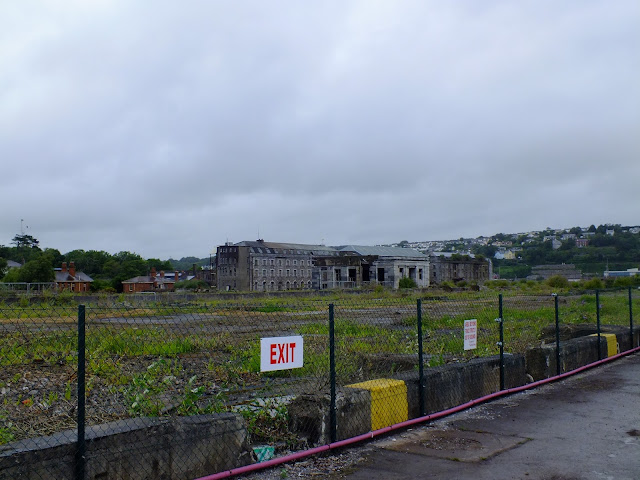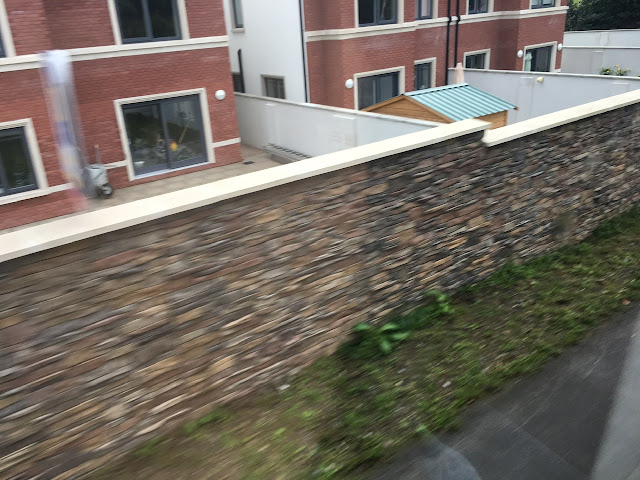The Walled Isle?
There’s one thing that’s always puzzled me about Ireland. Well, okay, there’s a bit more than just one thing, but this is one that stuck out. When you drive through Irish towns or cities, you’ll undoubtedly have noticed it. Many housing estates are surrounded by large concrete walls. Indeed, even the gardens of houses themselves are often separated by similar walls, only slightly lower than the towering perimeter walls. The same goes for industrial estates, and even bus stations or train stations. Hell, even parks are more often than not totally enclosed. Even the apartment complex where I live is effectively walled off. Granted, the architects were pretty sneaky about it, but it is still a fully walled-off and gated complex. Perversely though, the one type of property that you’d expect to be fortified to the hilt is often just secured by chain-link fences or old drystone walls: military bases. It’s something I saw with my own eyes on Haulbowline Island, the headquarters of the Irish Navy, back in 2015.
 |
| Yep, those chainlink fences are the only thing separating public land from the Naval Base at Haulbowline Island |
Where does this penchant for walling yourself in come from? And just to make sure we’re on the same page here, I’m not talking about historic dry stone or regular stone walls. I’m also focussing on the situation down here in the Republic of Ireland, so I won’t be going into the sordid history of the North, where some of these walls unfortunately still serve a purpose. For me, it’s more about the question why many housing estates, even new estates, are walled off like prisons,
It turns out that this isn’t such an easy question to answer. There’s virtually nothing on the actual reasons why these walls are so popular here on the emerald isle, though I do concede that I might not have used the correct search terms. There’s plenty of stuff available on how to build boundary walls, what to watch out for, but nothing on why so many estates go for high concrete walls instead of slightly lower walls or even simple fences. There’s also nothing on the subject of effectively public properties like train stations, bus stations, and similar structures being walled in. I know I’m not going to be able to come up with any answers by the time I’m done with this post.
One thing is for sure, this Irish fascination with walls goes back a VERY long way. Now, I know that I stated earlier that I’ll be focussing on modern instances of walls in Ireland, but indulge me here for a minute. You’ll see why. Back in 2015, while I visited my parents who were vacationing in Enniscrone at the time, we made a tour to the Céide Fields up on the coast of County Mayo. This is one of Ireland’s oldest archeological sites, and not only contains the oldest documented field systems in the world, dating back to roughly 3500 BCE, but in fact documents an entire settlement structure covered under sheets of blanket bogs. These fields are separated by stone walls, which in itself wouldn’t be unusual. However, it turns out that the houses discovered during excavations at the Céide Fields site also had individual gardens. Walled-in gardens to be precise, and the website of the site even makes a wry mention of the similarity to modern Ireland in the short history of the site on their website.
So, is it simply tradition? It could be one explanation, although drawing a line from bronze age farming communities to the modern, increasingly urbanising Ireland is VERY far-fetched suggestion. The Inclosure Acts passed in England from the 1600s onwards are certainly more recent, and the principle, if not the legal basis, would have been brought over to Ireland during the Cromwellian invasion and subsequent ethnic cleansing campaigns in the early 1650s. However, while this goes a long way towards explaining the prevalence of enclosed fields in the rural parts of Ireland, that still does not explain the preference for concrete walls to surround everything from train stations to back gardens. It certainly appears to be a rather recent development, and one mostly related to the development of private housing estates. Large public housing projects from the 1960s, such as Knocknaheeny or Mahon here in Cork, certainly don’t have external enclosing walls, although the individual back gardens are still regularly walled off.
 |
| Nope, that's not a prison, nor is it a sensitive diplomatic compound. That's purely a housing estate. |
 |
| Further up the same road in Cork, the picture is identical. High walls, and a prison-like air. |
 |
| We're not just talking about border walls here. The individual yards are themselves walled off. |
On the other hand, two private housing developments along Model Farm Road here in Cork, Rosefield and Riverside Farm, which are both being developed by the time of writing, appear more like prisons or immigration detention centers from the road, with an external perimeter wall reaching all the way up to the second floor. Similarly, the entire Cooper’s Grange / Waltham Abbey development here in Ballincollig, while not being completely walled in as such, is surrounded by a two-meter metal fence topping a low concrete wall. And naturally, all back gardens are walled off, creating spaces that seem less like refuges and more like containment cells. Again, what’s the motivation behind that? Why separate all these gardens with high walls when wooden fences would work just as well, and would actually be easier on the eye? Why turn housing estates into fortresses when any boundary enclosures could just as well be made out of metal or wooden fences, which would have the added advantage of not spoiling any views? On that note, has there been any investigation into the effects of these walled-off gardens into the mental health of the occupants of their respective houses, and the potential effects these “cells” for lack of a better word have on depression & suicide rates, particularly amongst young people?
Whatever the reasons, the effects are obvious, and not in a good way. Urban permeability, the ability to move from one area to the other, is almost completely eliminated. This isolates the estates from their respective surroundings, turning what would otherwise be a 30 second walk into a long drawn-out affair, and further encouraging the already excessive car use in Ireland. Take Ballincollig for example. Someone living in the back parts of Miller’s Court in the Cooper’s Grange development can easily see the Ballincollig Regional Park, a mere fifty to a hundred meters from their windows. However, to get into the park, they need to walk, cycle, or drive all the way to the main entrance to their estate, head onto a main road that also serves three schools, as well as other housing estates, and then turn into another road and through another estate to get to a park entrance. This is far from an isolated case, by the way. Open Google Maps, and check out any housing estate in Ireland, you’ll see the same picture: Roads within estates ending suddenly, only a few meters away from another road in another estate, but without any connection for pedestrians or cyclists. The houses on the other street might as well be on another planet.
Whatever the reasons, the lack of urban permeability, as well as the increased isolation and the potential effects on mental health are all reasons that this process of walling in needs to be stopped. Urban permeability must be drastically increased, and the landscape must be opened up dramatically. It would go a long way towards encouraging sustainable modes of transport like walking or cycling, and integrate what are effectively isolated communities. While I’m no clearer to finding the reason for this wall fetish than I was at the beginning of this post, I am absolutely clear that it must be stopped. It is time to tear down those walls!





Comments
Post a Comment